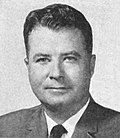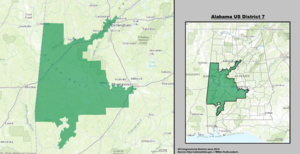Top Qs
Timeline
Chat
Perspective
Alabama's 7th congressional district
U.S. House district for Alabama From Wikipedia, the free encyclopedia
Remove ads
Alabama's 7th congressional district is a United States congressional district in Alabama that elects a representative to the United States House of Representatives. The district encompasses Choctaw, Dallas, Greene, Hale, Lowndes, Marengo, Pickens, Perry, Sumter and Wilcox counties, and portions of Clarke, Jefferson, and Tuscaloosa counties. The district encompasses portions of the Birmingham, Montgomery and Tuscaloosa/Northport urban areas. The largest city entirely within the district is Selma.
The district has been majority nonwhite, with a majority of African-American residents, since the redistricting following the 1990 census. As such, and with a Cook Partisan Voting Index rating of D+13, it is the most Democratic district in Alabama.[4] The district was adjusted due to the judicial selection of a new congressional map as a result of the case Allen v. Milligan, with its share of Montgomery and half of Clarke County shifted to the 2nd district and a portion of Tuscaloosa County given to the 4th district. It is currently represented by Democrat Terri Sewell.
Remove ads
Character
Summarize
Perspective
Alabama's 7th congressional district was first defined in 1843; it has continued since then with the exception of the years 1867–1873 during the Reconstruction era. The geographic area represented by this district has changed over time, depending upon the number of U.S. Representatives apportioned to Alabama. Around the turn of the 20th century, the district included the city of Gadsden. Over time, the district was redefined to include the area around Tuscaloosa. The last two representatives for the district before its reconfiguration as a majority-minority area were Richard Shelby and Claude Harris, both Tuscaloosa residents.
The shape of the current district was largely established in 1992, when it was reconstituted as a majority-minority district under provisions of the Voting Rights Act of 1965, as amended in 1982 to encourage greater representation for minorities in Congress.[5] Half of the western Alabama portion of the district was moved to the 4th district, and a large portion of Tuscaloosa County was moved into the 6th district, which had primarily been based around Birmingham. To counter the loss in population and to create the majority-minority, many counties from the Black Belt region, a rural expanse in Alabama with a high proportion of African-American residents descended from workers on cotton plantations, were added to the district, as was an arm extending from Tuscaloosa roughly along the Interstate 20/59 corridor into Jefferson County to take in most of the black precincts of Birmingham. Most of Birmingham's white residents remained in the 6th district. The three representatives elected from the district following reconfiguration—Earl F. Hilliard, Artur Davis, and Terri Sewell—have all been residents of Birmingham.
Mostly minor changes in the following two redistrictings have not substantially changed the shape of the district. But, western portions of Montgomery County have been restored to this district, including large swaths of inner-city Montgomery in the redistricting following the 2010 census. This area had earlier been removed after the 2000 census. The district contains urbanized areas of Birmingham, Montgomery, and Tuscaloosa, and ten of the fourteen rural counties in the Black Belt. Three of the state's largest colleges are located in the district: Alabama State University in Montgomery, the University of Alabama in Tuscaloosa, and the University of Alabama at Birmingham. Alabama's 7th Congressional district is a good example of a state that has experienced partisan gerrymandering over the last decade. In the 2010 redistricting cycle, Republicans drew district lines to pack together several major Democratic communities into a single district, ensuring that Democrats were only elected to one seat. Alabama's District 7 reaches into several other districts' regions to pick out Democratic voters. The 7th district is the most gerrymandered in the state.[6]
Democrats have represented the 7th district in all but 6 years since 1843.
Remove ads
Counties and communities
Summarize
Perspective
For the 119th and successive Congresses (based on the districts drawn following the Supreme Court's decision in Allen v. Milligan), the district contains all or portions of the following counties and communities.[7]
Choctaw County (8)
- All eight communities
Clarke County (6)
- Coffeeville, Fulton, Grove Hill, Jackson (part; also 2nd), Thomasville, Whatley
Dallas County (4)
- All four communities
Greene County (4)
- All four communities
Hale County (4)
- All four communities
Jefferson County (32)
- Adamsville, Bessemer, Birmingham (part; also 6th), Brighton, Brookside, Cardiff, Center Point (part; also 6th), Concord, Edgewater, Fairfield, Forestdale, Fultondale (part; also 6th), Graysville (part; also 6th), Helena (part; also 6th; shared with Shelby County), Homewood (part; also 6th), Hoover (part; also 6th; shared with Shelby County), Hueytown, Irondale (part; also 6th), Lake View (shared with Tuscaloosa County), Lipscomb, Maytown, McCalla, McDonald Chapel, Midfield, Minor, Mulga, North Johns, Pleasant Grove, Rock Creek, Sylvan Springs, Tarrant, West Jefferson
Lowndes County (7)
- All seven communities
Marengo County (10)
- All 10 communities
Perry County (2)
Pickens County (9)
- All nine communities
Sumter County (9)
- All nine communities
- Brookwood, Coaling, Cottondale, Holt (part; also 4th), Lake View (shared with Jefferson County), Moundville (shared with Hale County), Tuscaloosa (part; also 4th), Vance (part; also 6th; shared with Bibb County), Woodstock (part; also 6th; shared with Bibb County)
Wilcox County (7)
- All seven communities
Remove ads
Recent election results from statewide races
Summarize
Perspective
A majority of voters in the district are African Americans who support the Democratic Party and its candidates.
Remove ads
List of members representing the district
Remove ads
Recent election results
Summarize
Perspective
These are the results from the previous twelve election cycles in Alabama's 7th district.[9]
2002
2004
2006
2008
2010
2012
2014
2016
2018
2020
2022
2024
Remove ads
See also
References
Wikiwand - on
Seamless Wikipedia browsing. On steroids.
Remove ads

























